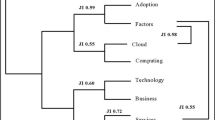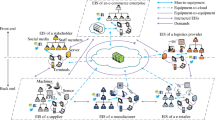The challenge of saturating all phases of pervasive service provision with context-aware functionality lies in coping with the complexity of maintaining, retrieving and distributing context information. To efficiently represent and query context information a sophisticated modelling scheme should exist. To distribute and synchronise context knowledge in various context repositories across a multitude of administrative domains, streamlined mechanisms are needed. This paper elaborates on an innovative context management framework that has been designed to cope with free-text and location based context retrieval and efficient context consistency control. The proposed framework has been incorporated in a multi-functional pervasive services platform, while most of the mechanisms it employs have been empirically evaluated.







Similar content being viewed by others
REFERENCES
M. Weiser, The computer for the 21st century, Scientific American, Vol. 265, No. 3, pp. 94–104, 1991.
M. Satyanarayanan, Pervasive computing: vision and challenges, IEEE Pervasive Computing, Vol. 8, No. 4, pp. 10–17, 2001.
S. Xynogalas, M. Chantzara, I. Sygkouna, S. Vrontis, I. Roussaki, and M. Anagnostou, Context management for the provision of adaptive services to roaming users, IEEE Wireless Communications, Vol. 11, No. 2, pp. 40–47, 2004.
F. Mahon, J. Mitic, M. Crotty, K. Doolin, and C. Kuhmuench, Pervasive Service Platform (PSP): Facilitating Pervasive Services, International Conference on Networking and Services, Silicon Valley, USA, 2006.
M. Strimpakou, I. Roussaki, C. Pils, and M. Anagnostou, COMPACT: Middleware for context representation and management in pervasive computing environments, to be published to the International Journal of Pervasive Computing and Communications (JPCC), Special Issue on ‘Pervasive Management,’ 2006.
I. Roussaki, M. Strimpakou, C. Pils, N. Kalatzis, and M. Anagnostou, Hybrid context modeling: A location-based scheme using ontologies, 3rd Workshop on Context Modeling and Reasoning (CoMoRea 2006), Pisa, Italy, 2006.
M. Strimpakou, I. Roussaki, C. Pils, P. Robertson, M. Angermann, and M. Anagnostou, Context Modelling and Management in Ambient-aware Pervasive Environments, International Workshop on Location and Context-Awareness (LoCA 2005), Oberpfaffenhofen, Germany, 2005.
K. Henricksen and J. Indulska, Developing context-aware pervasive computing applications: Models and approach, Journal of Pervasive and Mobile Computing, Vol. 2, No. 1, pp. 37–64, 2006.
C. Pils, I. Roussaki, and M. Strimpakou, Location-based Context Retrieval and Filtering, to be presented in the International Workshop on Location and Context-Awareness (LoCA 2006), Dublin, Ireland, 2006.
C. Becker and F. Dürr, On location models for ubiquitous computing, Personal and Ubiquitous Computing, Vol. 9, No. 1, pp. 20–31, 2005.
A. Beauliue and S. Mishra, Mastering Oracle SQL, O’Reilly,April 2002.
J. Clark and S. DeRose, XML Path Language (XPath), URL: http://www.w3.org/TR/xpath, 2006.
I. Ounis, G. Amati, B. Macdonald, and C. Johnson, Terrier Information Retrieval Plattform, 27th European Conference on IR Research (ECIR 2005), Santiago de Compostela, Spain, 2005. (LNCS, Vol. 3408, pp. 517–519)
J. V. Van Rijsbergen, Information Retrieval, Chapter 7: Evaluation, pp. 517–519, Butterworth Publishers, London, 1979.
M. Mouly and M.B. Pautet, The GSM System for Mobile Communications, Telecom Publishers, 1992.
P. Triantafillou and C. Neilson, Achieving strong consistency in a distributed file system, IEEE Transactions on Software Engineering, Vol. 23, No. 1, pp. 35–55, 1997.
R. Lenz, Adaptive distributed data management with weak consistent replicated data, ACM symposium on Applied Computing, Philadelphia, USA, pp. 178–185, 1996.
B. Ciciani, D. M. Dias, and P. S. Yu, Analysis of replication in distributed database systems, IEEE Transactions on Knowledge and Data Engineering, Vol. 2, No. 2, pp. 247–261, 1990.
J. Cho, and H. Garcia-Molina, The evolution of the web and implications for an incremental crawler, 26th International Conference on Very Large Data Bases, pp. 200–209, Cairo, Egypt, 2000.
J. Edwards, K. McCurley, and J. Tomlin, An adaptive model for optimizing performance of an incremental crawler, 10th International World Wide Web Conference, Hong Kong, China, 2001.
J. L. Wolf, M. S. Squillante, P. S. Yu, J. Sethuraman, and L. Ozsen, Optimal crawling strategies for web search engines, 11th International World Wide Web Conference, Honolulu, Hawaii, 2002.
Qi Han and N. Venkatasubramanian, Addressing timeliness/accuracy/cost tradeoffs in information collection for dynamic environments, 24th IEEE Real-Time Systems Symposium (RTSS), Cancun, Mexico, pp. 108–117, 2003.
OSGi Alliance, URL: http://www.osgi.org/, 2006.
D. Box, D. Ehnebuske, G. Kakivaya, A. Layman, N. Mendelsohn, H. Frystyk Nielsen, S. Thatte, and D. Winer, Simple Object Access Protocol (SOAP) 1.1, W3C Note 08, URL: http://www.w3.org/TR/SOAP, 2000.
E. Guttman, Service location protocol: Automatic discovery of IP network services, IEEE Internet Computing, Vol. 3, No. 4, pp. 71–80, 1999.
ACKNOWLEDGEMENTS
This work has been partially supported by the Integrated Project Daidalos (“Designing Advanced network Interfaces for the Delivery and Administration of Location independent, Optimised personal Services”), which is financed by the European Commission under the Sixth Framework Programme. However, this paper expresses the authors’ personal views, which are not necessarily those of the Daidalos consortium.
Author information
Authors and Affiliations
Corresponding author
Additional information
Ioanna Roussaki received her Diploma in Electrical and Computer Engineering in 1997 and her PhD in 2003 from the National Technical University of Athens (NTUA). Since 1999 she has been working as a researcher and lecturer in NTUA, and has participated in projects on communications, pervasive computing, context-awareness, virtual-home-environment, e-negotiations, etc.
Maria Strimpakou received her Diploma in Electrical and Computer Engineering from the National Technical University of Athens (NTUA) in 2000 and is currently pursuing a PhD degree working in the Computer Networks Laboratory of NTUA. Her research interests are in the areas of context-aware systems, ontology design, distributed environments, etc.
Carsten Pils received a Dipl.-Inform. degree in 1997 and a PhD in 2005 from the Technical University RWTH Aachen, Germany. Since 2005 he has been working for the Telecommunications Software and Systems Group at the Waterford Institute of Technology, Ireland. His current research interests include context-aware computing and information retrieval.
Rights and permissions
About this article
Cite this article
Roussaki, I., Strimpakou, M. & Pils, C. Distributed Context Retrieval and Consistency Control in Pervasive Computing. J Netw Syst Manage 15, 57–74 (2007). https://doi.org/10.1007/s10922-006-9053-6
Published:
Issue Date:
DOI: https://doi.org/10.1007/s10922-006-9053-6




